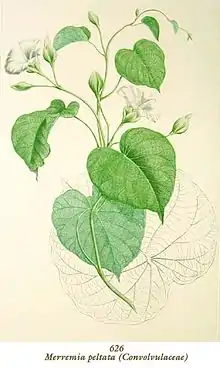Decalobanthus peltatus
Decalobanthus peltatus is a species of flowering vine in the morning glory family, Convolvulaceae, that is native to Pemba Island, the Mascarene Islands, Madagascar, the Seychelles, Indonesia, Malaysia, the Philippines, northern Queensland (Australia) and French Polynesia.[1] It has been introduced and subsequently become invasive on some of the other Pacific islands, such as New Caledonia, Samoa, Fiji, Solomon Islands, and Palau.[2][3][4][5]
| Decalobanthus peltatus | |
|---|---|
 | |
| Scientific classification | |
| Kingdom: | Plantae |
| Clade: | Tracheophytes |
| Clade: | Angiosperms |
| Clade: | Eudicots |
| Clade: | Asterids |
| Order: | Solanales |
| Family: | Convolvulaceae |
| Genus: | Decalobanthus |
| Species: | D. peltatus |
| Binomial name | |
| Decalobanthus peltatus (L.) A.R.Simões & Staples | |
| Synonyms | |
| |
As an invasive species in island habitats, Decalobanthus peltatus can completely cover trees, smothering and killing large areas of native forest; the resulting death of trees and loss of forests can cause less food for native birds and fruit bats and can also increase soil erosion, leading to increased sedimentation and death of coral reefs.[5]
For eradication of invasive populations, cutting the vines at the base will kill the tops and allow trees to recover. The vines will re-grow from the base, so it is best to uproot them if possible, but repeated cutting will exhaust and eventually kill the vines.[5] The vine's seeds will not germinate in the shade, so the best way to prevent invasive problems with this vine is to keep native forest intact.[5]
In Palau, where it is locally referred to by the name kebeas, public efforts have been taken to promote physical fitness and ecology by encouraging the community to use machetes to cut the vine.[4][5]
References
- "Merremia peltata". Germplasm Resources Information Network. Agricultural Research Service, United States Department of Agriculture. Retrieved 2011-04-12.
- "Merremia peltata (vine, climber)". Global Invasive Species Database. Invasive Species Specialist Group. Retrieved 2011-04-12.
- Hequet, Vanessa (2009). Les espèces exotiques envahissantes de Nouvelle-Calédonie (PDF) (in French). p. 17.
- Kesolei, Ongerung Kambes. "Here's a practical way to work out: Palau's two-pronged program promotes fitness while clearing invasive species". Pacific Note. Pacific Note. Retrieved 30 April 2020.
- "Invasive Species - Kebeas" (PDF). Office of the Palau Automated Land And Resource Information System (PALARIS). Office of the Palau Automated Land And Resource Information System (PALARIS). Retrieved 30 April 2020.
External links
![]() Media related to Decalobanthus peltatus at Wikimedia Commons
Media related to Decalobanthus peltatus at Wikimedia Commons